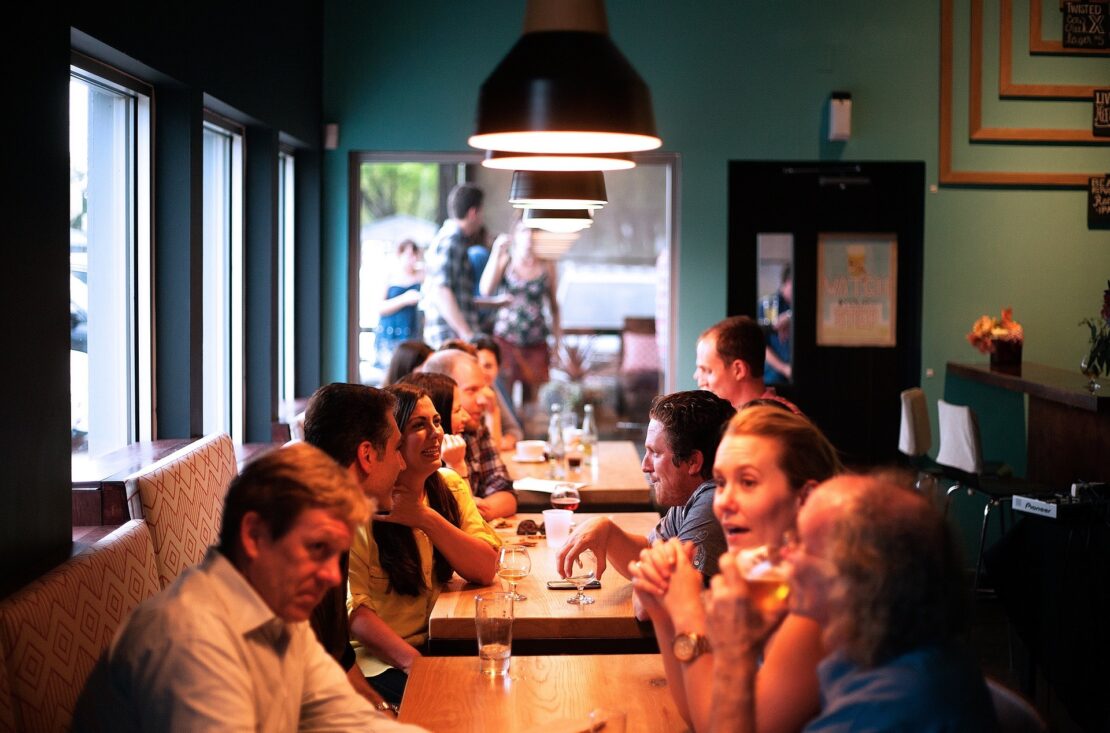Which public places are riskiest during the pandemic?
That’s the question researchers at Stanford University set out to answer with a new computer model.[1]
They analyzed cellphone data from 98 million Americans living in 10 major cities: Atlanta, Chicago, Dallas, Houston, Los Angeles, Miami, New York City, Philadelphia, San Francisco, and Washington, D.C.
The data showed where people went in the course of a day, how much time they spent there, and how crowded the places were. The venues in the analysis included restaurants, places of worship, gyms, hotels, coffee shops, grocery stores, and other indoor public spaces. The scientists then merged that information with data on coronavirus infections.
The verdict?
Full-service restaurants were by far the riskiest public places.[2]
They were found to be four times more dangerous than places with the next highest level of infection risk. Restaurants were followed by gyms, hotels, coffee shops, places of worship, grocery stores, and medical facilities.[3]
The findings confirm those of another recent study by the Centers for Disease Control and Prevention. It found that adults across 11 U.S. cities who tested positive were twice as likely to have dined out within the previous two weeks than those who tested negative.[4]
The researchers noted that restaurants may be higher risk than other public places because customers must remove their masks to eat.
Neither study differentiated between indoor and outdoor dining. But the Stanford study does suggest that higher infection rates are linked to crowded indoor spaces.[5]
Their model showed that distancing reduces the risk of dining out. The study found that limiting restaurants to one-fifth of capacity reduced infections by 80%.
One more thing…
Many people are waiting until they get vaccinated to begin eating at indoor restaurants again. But for some, this is a major problem because they fear needles.
This is a surprisingly common fear called trypanophobia. It affects about 50 million Americans, according to the Diagnostic and Statistical Manual of Mental Disorders.[6]
Some cases of trypanophobia are so severe that even when directly faced with the prospect of death, a person with the condition will choose death over getting a shot.
But a recent study discovered a way to make injections less of an ordeal.
Simple Trick to Make Shots Less Painful
If you dread getting stuck by a needle, a new study has uncovered a strategy that might help.
Forcing a wide smile reduces injection pain by 40%, according to research by scientists at the University of California, Irvine. Grinning also has a calming effect, reducing heart rate and anxiety, the study found.[7]
Surprisingly, a grimace also created those same responses.
The wrong strategy? A poker face.
Professor Sarah Pressman led the study. “We found that these movements (a grin or a grimace), as opposed to a neutral expression, are beneficial in reducing discomfort and stress,” she said.
The study included 231 people who reported their levels of pain and distress when injected with saline solution using a 25-gauge needle. That’s the size typically used with a flu shot.
(For coronavirus vaccines, larger 21-gauge needles are being used. The higher the gauge number, the thinner the needle.)[8]
Participants were asked to express a smile, a grimace, or a neutral expression as the needle went into the arm. Those who smiled or grimaced reported the shot hurt only about half as much as those who kept a straight face.
The research was published in the journal Emotion.
Professor Pressman said that smiling or grimacing is “a simple, free, and clinically meaningful method of making a needle injection less awful.”[9]
Read More About the Coronavirus Here
- NEW COVID TREATMENT HOPE: She lay dying of COVID-19 on a ventilator in a Buffalo hospital. Doctors gave her just a 20% chance to live. But after getting this treatment, she made “a complete turnaround,” her son said. Click HERE to read more.
- Are COVID Vaccines Safe? A new report provides detailed side effect information. Click HERE to read more.
- Will You Suffer an Allergic Reaction to the Coronavirus Vaccine? Answer these four question to gauge your risk. Click HERE to read more.
[1] https://www.nature.com/articles/s41586-020-2923-3
[2] https://sf.eater.com/21561143/covid-19-restaurants-indoor-dining-stanford-chan-zuckerberg
[3] https://www.washingtonpost.com/health/2020/11/10/coronavirus-restaurants-gyms-hotels-risk/
[4] https://www.cdc.gov/mmwr/volumes/69/wr/mm6936a5.htm
[5] https://www.nytimes.com/2020/11/10/health/covid-indoor-venues-infections.html?smtyp=cur&smid=tw-nytnational
[6] https://pharmajet.com/fear-needles-fatal-phobia/
[7] https://socialecology.uci.edu/news/smiling-sincerely-or-grimacing-can-significantly-reduce-pain-needle-injection
[8] https://www.fda.gov/media/144413/download
[9] https://www.painnewsnetwork.org/stories/2020/12/3/a-smile-or-grimace-makes-vaccine-shots-less-painful-nbsp

